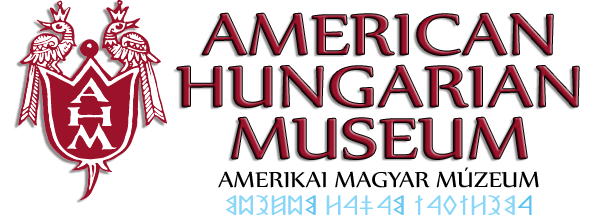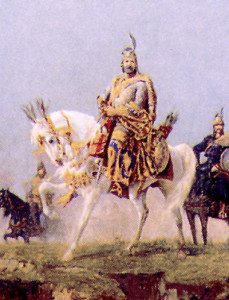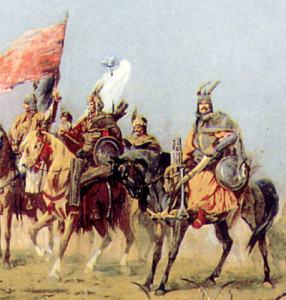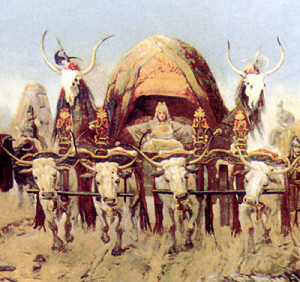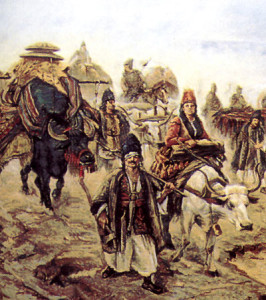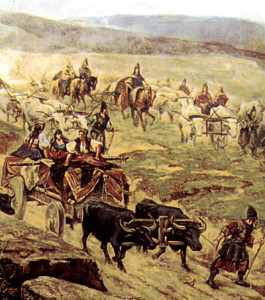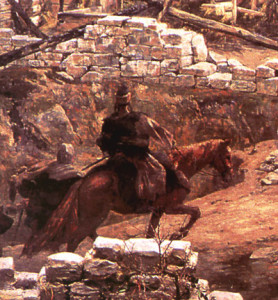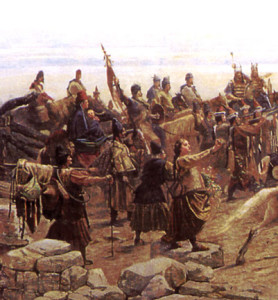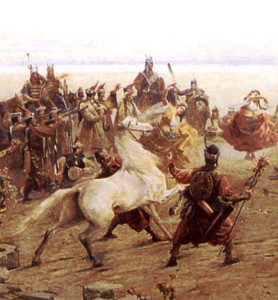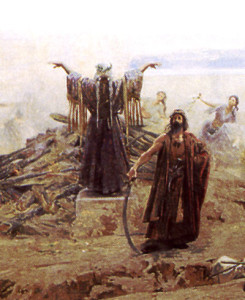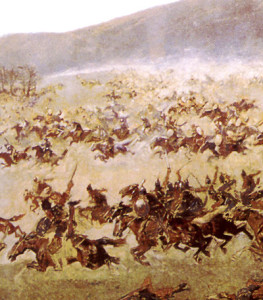THE FESZTY PANORAMA PAINTING
The Feszty Panorama tells the story of the return of
Hungarians to the Carpathian Basin in 896.
The panorama, predecessor of cinema and television, is a separate art category. Its origin dates back 2000 years, to the time of classic Rome. It was revived in Renaissance times, and is still popular, having its peak in the 19th century. It places the viewer in the middle of a circular painting. Optical illusion is further enhanced by a built-in foreground, a proscenium leading from the feet of the viewer towards the painting, giving more dimension to one’s peripheral vision. Feszty’s Panorama, entitled The Arrival of the Magyars rises above its contemporaries, of which about twenty survived.
Árpád Feszty (1856-1914), a talented and popular painter, was on a study tour in Paris in 1890 when he first saw a panorama. The huge painting depicted a battle of Napoleon. The enthusiastic Feszty decided to paint one, immortalizing the Great Flood. His father-in-law, Mór Jókai, the greatest romantic Hungarian writer of his time, persuaded Feszty to paint the arrival of the conquering Hungarians, which would be more adequate as this was a special time in Hungary’s history. The country was preparing to celebrate the millennium of her statehood. Everywhere in the country something lasting and worthy to the nation’s great past was planned. At this time the tracks of the first subway in continental Europe had been laid down under the Andrássy Avenue between the beautiful palaces of Budapest. The colonnade, with the most famous personalities of Hungarian history, was built on Hero’s Square. Therefore Feszty’s plan to paint King Árpád and his chiefs seemed an excellent theme to suit the festive atmosphere of the anniversary. It was expected that he would receive the assistance needed to succeed in this gigantic undertaking. Budapest provided the area where the special building for the painting could be erected. His brother Gyula Feszty, a prominent architect, designed and built the round structure needed for the Panorama in record time. He also formed a joint-stock company, which provided the necessary financial support.
Feszty wanted to paint the historical moment as authentically as possible. He didn’t spare money, time and trouble to prepare himself adequately. He studied history, searched libraries, corresponded with Russian scientists, studied ancient Central Asian armament and clothing. He ordered pictures and costumes from Asia Minor, researched the collection of the Hungarian Ethnographic Museum, photographed earthworks, and made sketches in oil, pastel and charcoal. To record the landscape authentically, Feszty traveled to the Verecke Pass in 1892, where Árpád and his people entered the Carpathian Basin. Feszty and three friends, painters Ignác Újvári, Béla Spányi and László Mednyánszky built a veranda like structure with four open sides on a little hill in the valley of Volóc, west of the Verecke-Pass. From its windows the artists drew the surrounding landscape: the snow-covered mountains of Szolyva, the Munkács Hill, the Latorca-Valley and the slopes of Verecke. Pasting the four cardboards together, they could see the whole landscape, which Feszty’s imagination then filled with nearly 2000 characters.
The sketches made at the Verecke pass were projected onto the gigantic 120 meter long and 14.5 meter wide canvas. One ton (1000 kg) of paint was used for the 1725 m2 large masterpiece.
According to the contract with the Capital, the Panorama had to be painted and mounted in two years. The time pressure made those involved work day and night. By the time the specially woven linen of 8 meters in width arrived from Belgium, the structure on which the canvas had to be hung was ready. Róza Jokai, wife of Feszty, a painter herself, imagining the monstrous work awaiting her husband, fainted when she saw the huge surface. It took two months to paint the background: sky and clouds. This enormous work was done by Feszty alone, this way being able to give the panorama its extraordinary ambience. He also painted the chiefs on the hill, — portraying himself in Árpád’s figure –, as well as the wagons, oxen and the rocks in the foreground. The artists worked on scaffolding of several stories in height, which could be moved on railroad tracks in front of the canvas.
It would have been physically impossible for Feszty to paint the whole surface by himself, therefore he chose more then 20 artists to help him. Ujváry, Mednyánszky, Béla Spányi and Ferenc Olgyay were responsible for the background landscapes. Master of the cavalry charge was Pál Vágó. Mrs. Róza Jókai Feszty painted the dead, — and made huge amounts of coffee. Pista Dankó and his orchestra played day and night to keep the artist on the scaffolding awake. The people of the country were regularly informed of the progress by the contemporary press. Several anecdotes spread about the cheerful but extremely tired artist group. The proscenium was built during the last month. It was a sensational technical novelty that real water was running from the Latorca spring.
The opening ceremony took place on Pentecost, the 12th of May 1894. The press wrote with enthusiasm about the occasion which was considered the overture of the millennium festivities. The enormous number of visitors, even by today’s standard, was amazed by the huge, three-dimensional painting, the chiefs, the cavalry charge, the sacrifice of the white horse, the general of the camp, the abduction of women and the majestic arrival of the families. Feszty fitted these six major scenes into the landscape in such an artistic way, that they make the view continuous. The Panorama had a fantastic success not only in Hungary, but also at the World Expo in London at the end of the 19th century.
In 1909, the Panorama returned to Hungary from its long European journey. It had to move to a new location, because the old building was torn down making place for the Museum of Fine Arts. In 1944, during the siege of Budapest, the home of the Panorama was bombed, and two-thirds of the painting was burned. After the war, it was stored at different locations, the last one being the National Gallery.
Finally, in 1975, the conservation of this valuable masterpiece was started in Szeged. Between 1991-1995, Polish artists restored the Panorama, which was dedicated and reopened to the public on the 14th of July 1995. Now in 1996, when Hungary celebrates her millecentenarium, the painting can be seen in its old glory and its own building at Ópusztaszer National Historic Park. Feszty’s talent and love for his people lives on in the gigantic magical Panorama The Arrival of the Hungarians, which commemorates, in a worthy way, the founders of our nation of 1100 years ago.
Emese Kerkay
Bibliography:
Magyar Életrajzi Lexikon, Akadémiai Kiadó Budapest 1967
Ősi Gyökér, XXIII. 4. okt.-dec. 1995. Feszty Masa könyve alapján írt cikk
“Mit kell tudni a Feszty körképről”
Pesti Hírlap Lexikona, Budapest 1937
Trogmayer Ottó szegedi múzeumi igazgató írása egy, a Feszty-körkép színes
reprodukcióit tartalmazó, 1996-ban kiadott naptárban
